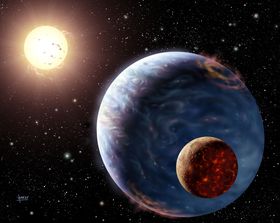Cartenia: Difference between revisions
Nicesociety (talk | contribs) No edit summary |
Nicesociety (talk | contribs) No edit summary |
||
| Line 8: | Line 8: | ||
==Environment == | ==Environment == | ||
While technically Class M, Cartenia is considered | While technically Class M, Cartenia is considered unpleasant by most humanoid species. The Polar Regions rarely make it above negative ten degrees Celsius and have temperatures as low as negative thirty degrees. Lower latitudes generally see much water temperatures. The equatorial region has been known to see air temperatures as high as thirty-five degrees. Harsh winds blanket the planet, especially at the poles. While the Cartenians evolved in this environment, they have largely forsaken it in favor of more comfortable artificial environments. | ||
==Locations== | ==Locations== | ||
Revision as of 17:32, 21 February 2009
Cartenia was the original homeworld to the Cartenians. approximately 500 years ago, there was a war which poisoned the atmosphere and caused the biosphere to fail. The Cartenian factions fighting came to a ceasefire and attempted to repair the damage that they had doen to their planet but were unable to do so. They eventually left, with each faction establishing colonies on the planets Arturia Prime and Meldovia III.
Eventually these two factions once again went to war and continued fighting for another 400 years.
The planet was located somewhere between the Orion Syndicate and the United Federation of Planets.
Environment
While technically Class M, Cartenia is considered unpleasant by most humanoid species. The Polar Regions rarely make it above negative ten degrees Celsius and have temperatures as low as negative thirty degrees. Lower latitudes generally see much water temperatures. The equatorial region has been known to see air temperatures as high as thirty-five degrees. Harsh winds blanket the planet, especially at the poles. While the Cartenians evolved in this environment, they have largely forsaken it in favor of more comfortable artificial environments.
Locations
Jinsar was the capital city of Cartenia and housed the Parliament building. Jinsar is also a former center for manufacturing and the oldest large city on Cartenia. Jinsar existed during the time of the Great War and there are still some relics of the conflict if one knows where to look. While a modern city, Jinsar still has some old world charm.
Polomus is the largest city on Cartenia and unlike Jinsar has only a couple of centuries of history. It was also the host of the famous Amorta race. The undersea wreck of the Leesin Detra (Lees's Honor) was a popular site for visitors to Cartenia. It was the largest shipwreck every recorded in the history of Cartenia and sank in the 19th century.
This planet was first mentioned in the USS Rosenante mission Letters of Marques.
